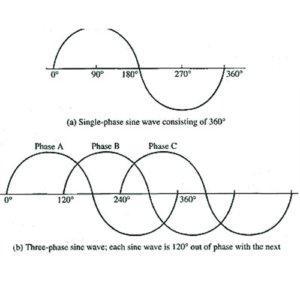You need to buy a generator for your premises and are stumped when asked if you need a single-phase machine or a three-phase one. Take heart, you are not the only one confused; a large number of people are clueless about electrical jargon. However, understanding the difference between single and Three-phase generators is not that difficult. Both generators provide the same type of power. But they vary in the way that they provide it.
How to build a self powered generator?”

Fundamentals
Producing one single voltage that alternates constantly, single-phase power is generated in one single wave. Three-phase generators produce three separate waves of power, operating in a sequence. The level of power from a single-phase generator varies throughout its cycle. Three-phase generators provide a constant level of power.
While two wires are needed to complete the circuit in a single phase; a Three-phase system requires four wires. Karen Lao from Kruger Power explains that there is one conductor in a single-phase generator, and three conductors in a three-phase generator. The conductors carry the current and the neutral returns it to complete the circuit.
Single-phase Generator
Power flows through a single conductor which means that the generator requires two wires (phase and neutral) to complete the circuit. Single-phase generators need additional circuits to start-up as they do not produce a rotating magnetic field. The voltage from single-phase generators depends on the country of use. Generally, this is either 110 or 240 volts. The frequency range is fifty or sixty Hertz. Single-phase generators are not usually available at power ratings above 10kW. This makes it ideal for applications that require low loads such as residences, small tools and equipment, and for rural areas. One of the issues with a single-phase is that since it operates with one phase wire, any fault can shut down the entire system. This also means that any single piece of equipment could consume 100 percent of the power generated. However, this also makes it easy to control the load that is being supported, thus reducing the chances of a breakdown due to overloading.
Three-phase Generator
Power flows through three conductors which translate to four wires (three-phase wires and one neutral). Three-phase generators are available up to 480 volts. Since the generator operates on three phases, if one of them goes down due to a fault, the generator will still supply through the other two phases. This makes it more efficient than a single-phase generator. However, it is very important to control the load on each phase to avoid overloading and thus breakdowns. Three-phase generators are ideal for applications that use large loads such as commercial businesses, industrial locations, and data centers. Three-phase generators do cost more, both to purchase and operate. However, their reliability and efficiency make them a better choice for an uninterrupted power supply.
Which one do you need?
The details given above should clear the air regarding your choice between single and three-phase generators. However, it is worth remembering that given a similar power rating a single-phase generator is usually a little more expensive than a three-phase generator.



